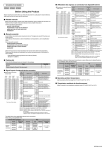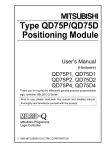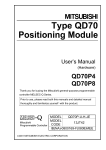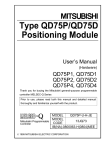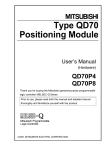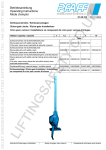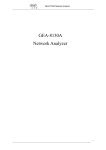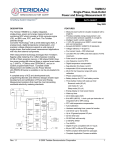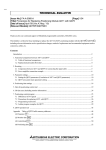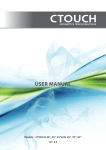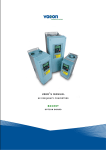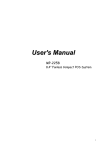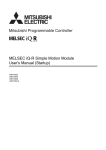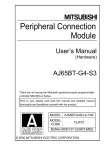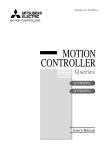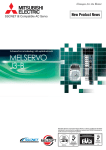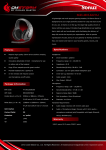Download Positioning Module
Transcript
Positioning Module User's Manual (Installation) QD75MH1 QD75MH2 QD75MH4 Thank you for buying the Positioning Module. Prior to use, please read both this manual and detailed manual thoroughly and familiarize yourself with the product. ©2005 MITSUBISHI ELECTRIC CORPORATION ‚ SAFETY INSTRUCTIONS ‚ (Always read these instructions before using this equipment.) Before using this product, please read this manual and the relevant manuals introduced in this manual carefully and pay full attention to safety to handle the product correctly. The instructions given in this manual are concerned with this product. For the safety instructions of the programmable controller system, please read CPU module User's Manual. In this manual, the safety instructions are ranked as "DANGER" and "CAUTION". DANGER Indicates that incorrect handling may cause hazardous conditions, resulting in death or severe injury. CAUTION Indicates that incorrect handling may cause hazardous conditions, resulting in medium or slight personal injury or physical damage. Note that the ! CAUTION level may lead to a serious consequence according to the circumstances. Always follow the instructions of both levels because they are important to personal safety. Please store this manual in a safe place and make it accessible when required. Always forward it to the end user. [INSTALLATION PRECAUTION] ! CAUTION ‚ Use the PLC within the general specifications environment given in the CPU module User's Manual to use. Using this PLC in an environment outside the range of the general specifications may cause electric shock, fire, malfunction, and damage to or deterioration of the product. ‚ While pressing the installation lever located at the bottom of module, insert the module fixing tab into the fixing hole in the base unit until it stops. Then, securely mount the module with the fixing hole as a supporting point. Incorrect loading of the module can cause a malfunction, failure or drop. When using the module in the environment of much vibration, tighten the module with a screw. Tighten the screws within the specified torque range. Undertightening can cause a drop, short circuit or malfunction. Overtightening can cause a drop, short circuit or malfunction due to damage to the screws or module. ‚ Completely turn off the externally supplied power used in the system before installing or removing the module. Not doing so may damage the product. ‚ Do not directly touch the module's conductive parts and electronic components of the module. Touching the conductive parts and electronic components of the module could cause an operation failure or give damage to the module. A-1 [WIRING PRECAUTION] ! DANGER ‚ Completely turn off the externally supplied power used in the system before installing or placing wiring. Not doing so may cause electric shock or damage to the product. ! CAUTION Check the layout of the terminals and then properly route the wires to the module. Solder connector for external input signal cable properly. Insufficient soldering may cause malfunction. Be careful not to let foreign matter such as sawdust or wire chips get inside the module. These may cause fires, failure or malfunction. The top surface of the module is covered with protective films to prevent foreign objects such as cable off cuts from entering the module when wiring. Do not remove this film until the wiring is complete. Before operating the system, be sure to remove the film to provide adequate ventilation. Securely connect the connector for SSCNET cable to the bottom connector on the module. When removing the cable or power supply cable from the module, do not pull the cable. When removing the cable with a connector, hold the connector on the side that is connected to the module. Pulling the cable that is still connected to the module may cause malfunction or damage to the module or cable. The cable used for connecting the QD75MH external input signal cable and SSCNET cable should not be routed near or bundled with the main circuit cable, power cable and/or other such load carrying cables other than those for the PLC. These cables should be separated by at least 100mm (3.94inch). They can cause electrical interference, surges and inductance that can lead to mis-operation. When pulling out SSCNET cable from SSCNET connector, be sure to put the cap on SSCNET connector. If the end face of SSCNET connector is dirty, optical transmission is interrupted and it may cause malfunctions. Do not see directly the light generated from SSCNET connector of servo amplifier or QD75MH. When the light gets into eye, may feel something is wrong for eye. (The light source of SSCNET corresponds to class1 defined in JISC6802 or IEC60825-1.) If SSCNET cable is added a power such as a major shock, lateral pressure, haul, sudden bending or twist, its inside distorts or breaks, and optical transmission will not be available. SSCNET cable should be given loose slack to avoid from becoming smaller than the minimum bend radius, and it should not be twisted. Make sure to use SSCNET cable within the range of operating temperature described in this manual. The optical cable and code part melts down if being left near the fire or high temperature. Therefore, do not make it touched the part which becomes high temperature, such as radiator or regenerative brake option of servo amplifier, or servomotor. A-2 ! CAUTION ‚ Make sure to lay SSCNET cable with greater radius than the minimum bend radius. (Refer to the Section 5.2 Precautions for SSCNET cable wiring.) ‚ Fix the optical cable at the closest part to the connector with bundle material in order to prevent SSCNET cable from putting its own weight on SSCNET connector. ‚ Never use vinyl tape for optical cord. Plasticizing material in vinyl tape goes into optical fiber and lowers the optical characteristic. At worst, it may cause wire breakage. If using adhesive tape for the optical cable laying, the fire resistant acetate cloth adhesive tape 570F (Teraoka Seisakusho Co., Ltd) is recommended. If laying with other wires, do not make the optical cable touched wires or cables made from soft polyvinyl chloride (PVC), polyethylene resin (PE), teflon (Fluorocarbon resin) or nylon which contains plasticizing material. ‚ If the adhesion of solvent and oil to the code part of SSCNET cable may lower the optical characteristic and machine characteristic. If it is used such an environment, be sure to do the protection measures to the optical cord. ‚ When storing, put a cap on the connector part for preventing the connector edge of SSCNET from getting dirt, dust and so on. ‚ SSCNET connector is put a cap to protect light device inside connector from dust. For this reason, do not remove a cap until just before mounting SSCNET cable. Then, when removing SSCNET cable, make sure to put a cap. ‚ Keep the cap for SSCNET connector and the tube for protecting light code end of SSCNET cable in a plastic bag with a zipper of SSCNET cable to prevent them from becoming dirty. ‚ When changing the servo amplifier or QD75MH, make sure to put cap on SSCNET connector. When asking repair of servo amplifier for some troubles, make sure to put a cap on SSCNET connector. When the connector is not put a cap, the light device may be damaged at the transit. In this case, exchange and repair of light device is required. A-3 REVISIONS Print Date May, 2005 * Manual Number IB (NA) 0300099-C First Edition Revision This manual confers no industrial property rights or any rights of any other kind, nor does it confer any patent licenses. Mitsubishi Electric Corporation cannot be held responsible for any problems involving industrial property rights which may occur as a result of using the contents noted in this manual. ø 2005 MITSUBISHI ELECTRIC CORPORATION A-4 CONTENTS 1. Overview .......................................................................................................................... 1 2. Specifications ................................................................................................................... 2 3. Handling ........................................................................................................................... 3 3.1 Handling Precautions................................................................................................. 3 4. Part Identification Nomenclature...................................................................................... 4 5. Wiring ............................................................................................................................... 7 5.1 Wiring Precautions..................................................................................................... 9 5.2 Precautions for Wiring The SSCNET Cable ..........................................................12 5.3 SSCNET Cable Wiring ...........................................................................................14 5.4 External Interface.......................................................................................................15 6. External Dimensions ........................................................................................................16 A-5 About Manuals There are following manuals for this product. If it is required, please make this table reference and request it. Relevant Manuals Manual Number Manual Name (Model Code) Type QD75MH Positioning Module User’s Manual (Details) IB-0300117 GX Configurator-QP Version2 Operating Manual SH-080172 (1XB917) (13JU19) Conformation to the EMC Directive Instruction For details on making Mitsubishi PLC conform to the EMC directive instruction when installing it in your product, please refer to Chapter 3, "EMC Directive and Low Voltage Instruction" of the using PLC CPU module User's Manual (Hardware). The CE logo is printed on the rating plate on the main body of the PLC that conforms to the EMC directive instruction. For the other EMC Directive guidelines on the servo amplifier and the servomotor, refer to the" EMC INSTALLATION GUIDELINES" (IB (NA)-67303). A-6 1. Overview This manual explains how to handle the Positioning Module, model numbers QD75MH1, QD75MH2, QD75MH4 (hereinafter collectively referred to as the QD75MH). After unpacking the QD75MH, please verify that the corresponding product as listed below is enclosed in the package. Model name QD75MH1 QD75MH2 QD75MH4 Description QD75MH1 Positioning Module (Single-axis SSCNET type) QD75MH2 Positioning Module (Dual-axis SSCNET type) QD75MH4 Positioning Module (Four-axis SSCNET type) Quantity 1 1 1 Important The user should arrange for a connector for external input signal cable and SSCNET provided in the package. * Connector type ‚ A6CON1 (Soldering type) ‚ A6CON2 (Crimp-contact type) ‚ A6CON3 (Pressure-displacement type) ‚ A6CON4 (Soldering type, useable for straight out and diagonal out) * A6CON2 Crimp-contact tool ‚ Model name: FCN-363T-T005/H * A6CON3 Pressure-displacement tool ‚ Model name: FCN-367T-T012/H (Locator Plate) : FCN-707T-T001/H (Cable Cutter) : FCN-707T-T101/H (Hand Press) ‚ Supplier’s offices : cable since it is not FUJITSU COMPONENTS AMERICA,INC 250E Caribbean Drive Sunnyvale, CA 94089 U. S. A Tel : (1-408) 745-4900 FUJITSU COMPONENTS EUROPE B.V. Diamantlaam 25, 2132 WV Hoofddorp, The Netherlands Tel : (31) 23-5560910 FUJITSU COMPONENTS ASIA PTE LTD 102E Pasir Panjang Road, # 04-01 Citilink Warehouse Complex, Singapore 118529 Tel : (1-408) 745-4900 FUJITSU COMPONENTS HONG KONG Suite 913 Ocean Centre, 5 Canton Road. TST, CO., LTD. Kowloon, Hong Kong Tel : (852) 2881-8495 FUJITSU ELECTRONIC COMPONENTS Rm 3105, Bund Center, 222 Yan An Rd(E), Shanghai, 200002 (SHANGHAI) CO., LTD. Tel : (86) 21-6335-2560 1 2. Specifications (1) The specifications for the QD75MH1, QD75MH2 and QD75MH4 Item Number of axes (axis) SSCNET cable SSCNET length cable over all Applicable wire size Applicable connector Number of I/O occupied points (points) 5 V DC current consumption (A) External dimensions (mm/inch) Weight (kg/lb.) Specification QD75MH2 QD75MH1 QD75MH4 1 2 4 ‚ Connection between QD75MH and MR-J3-¸B. ‚ Connection between MR-J3-¸B and MR-J3-¸B. MR-J3BUS M ‚ Standard code for inside panel. (Note-1) ‚ 0.15m(0.49ft.), 0.3m(0.98ft.), 0.5m(1.64ft.), 1m(3.28ft.), 3m(9.84ft.) ‚ Connection between QD75MH and MR-J3-¸B. ‚ Connection between MR-J3-¸B and MR-J3-¸B. MR-J3BUS M-A ‚ Standard code for outside panel. (Note-1) ‚ 5m(16.40ft.), 10m(32.81ft.), 20m(65.62ft.) ‚ Connection between QD75MH and MR-J3-¸B. ‚ Connection between MR-J3-¸B and MR-J3-¸B. MR-J3BUS M-B ‚ Long distance cable. (Note-1) ‚ 30m(98.43ft.), 40m(131.23ft.), 50m(164.04ft.) The cable length of the SSCNET cable depends on the cable type. MR-J3BUS¸M: The cable length is 3m(0.98ft.) max. / MR-J3BUS¸M-A: The cable length is 20m(65.62ft.) max. / MR-J3BUS¸M-B: The cable length is 50m(164.04ft.) max. 2 0.3 mm (when A6CON1/A6CON4 is used), AWG#24 to 28 (when A6CON2 is used), AWG#28 (twised) or AWG#30 (single wire) (when A6CON3 is used) A6CON1, A6CON2, A6CON3, A6CON4 (sold separately) 32 (I/O assignment: Intelligent function module 32 ) 0.60 0.60 0.60 98 (3.86) (H) · 27.4 (1.08) (W) · 90 (3.54) (D) 0.15 (0.33) 0.15 (0.33) 0.16 (0.35) (Note-1) : ¸ = Cable length (015: 0.15m (0.49ft.), 03: 0.3m (0.98ft.), 05: 0.5m (1.64ft.), 1: 1m (3.28ft.), 3: 3m (9.84ft.), 5: 5m (16.40ft.), 10: 10m (32.80ft.), 20: 20m (65.62ft.), 30: 30m (98.43ft.), 40: 40m (131.23ft.), 50: 50m (164.04ft.) ) (Note-2) : For the general specifications of the QD75MH, see the "User's Manual for the CPU module used". 2 3. Handling ! CAUTION ‚ Use the PLC within the general specifications environment given in the CPU module User's Manual to use. Using the PLC outside the general specification range environment could lead to electric shocks, fires, malfunctioning, product damage or deterioration. ‚ While pressing the installation lever located at the bottom of module, insert the module fixing tab into the fixing hole in the base unit until it stops. Then, securely mount the module with the fixing hole as a supporting point. Incorrect loading of the module can cause a malfunction, failure or drop. When using the module in the environment of much vibration, tighten the module with a screw. Tighten the screws within the specified torque range. Undertightening can cause a drop, short circuit or malfunction. Overtightening can cause a drop, short circuit or malfunction due to damage to the screws or module. ‚ Completely turn off the externally supplied power used in the system before installing or removing the module. Not doing so may damage the product. ‚ Do not directly touch the module's conductive parts and electronic components of the module. Touching the conductive parts and electronic components of the module could cause an operation failure or give damage to the module. 3.1 Handling Precautions (1) Since the module case is made of resin, do not drop it or subject it to strong impact. (2) The module can easily be secured to the base unit using the hooks located at the top of the module. However, if the module is to be placed in an area that is subject to strong vibration or impact, we recommend that it is secured with module mounting screws (to be provided by the user). In this case, tighten the module mounting screws within the following torque range. Module mounting screws (M3 · 12): Tightening torque range is from 0.36 to 0.48 N©m. 3 4. Part Identification Nomenclature (1) Part identification nomenclature (a) QD75MH1 (b) QD75MH2 QD75MH1 RUN (c) QD75MH4 QD75MH2 AX1 RUN 1) ERR QD75MH4 AX1 AX2 RUN 1) ERR ERR AX1 AX2 AX1 AX3 AX4 2) QD75MH1 1) QD75MH4 AX1 AX2 2) 2) 3) 3) QD75MH2 3) Number AX1 AX2 AX3 AX4 Name Number 1) LED display 3) 2) External device connector Name SSCNET cable connector (2) LED display contents QD75MH4 RUN ERR AX1 AX2 AX3 AX4 LED name Display contents RUN On: Operating normally Off: Hardware error/ watch dog timer error occurrence AX1 On: Axis 1 is operating Flashing: Axis 1 error Off: Axis 1 is stopped AX2 On: Axis 2 is operating Flashing: Axis 2 error Off: Axis 2 is stopped AX3 On: Axis 3 is operating Flashing: Axis 3 error Off: Axis 3 is stopped AX4 On: Axis 4 is operating Flashing: Axis 4 error Off: Axis 4 is stopped ERR On: System error occurrence Flashing: Axis error Off: Normal All LED on the QD75MH may be ON when there is an error in the QD75MH hardware. 4 (3) External device connector signal layout Pin layout B20 B19 B18 B17 B16 B15 B14 B13 B12 B11 B10 B9 B8 B7 B6 B5 B4 B3 B2 B1 A20 A19 A18 A17 A16 A15 A14 A13 A12 A11 A10 A9 A8 A7 A6 A5 A4 A3 A2 A1 Front view of the module Axis 4 (AX4) Axis 3 (AX3) Axis 2 (AX2) Axis 1 (AX1) Pin No. Signal name Pin No. Signal name Pin No. Signal name Pin No. Signal name 2B20 2B19 2B18 2B17 2B16 2B15 2B14 2B13 2B12 2B11 2B10 2B9 2B8 2B7 2B6 2B5 2B4 2B3 2B2 2B1 No connect No connect No connect No connect No connect No connect No connect No connect No connect No connect No connect No connect No connect COM COM CHG STOP DOG RLS FLS 2A20 2A19 2A18 2A17 2A16 2A15 2A14 2A13 2A12 2A11 2A10 2A9 2A8 2A7 2A6 2A5 2A4 2A3 2A2 2A1 No connect No connect No connect No connect No connect No connect No connect No connect No connect No connect No connect No connect No connect COM COM CHG STOP DOG RLS FLS 1B20 1B19 1B18 1B17 1B16 1B15 1B14 1B13 1B12 1B11 1B10 1B9 1B8 1B7 1B6 1B5 1B4 1B3 1B2 1B1 PULSER BPULSER ANo connect No connect No connect P5 SG No connect No connect No connect No connect No connect EMI.COM COM COM CHG STOP DOG RLS FLS 1A20 1A19 1A18 1A17 1A16 1A15 1A14 1A13 1A12 1A11 1A10 1A9 1A8 1A7 1A6 1A5 1A4 1A3 1A2 1A1 PULSER B+ PULSER A+ No connect No connect No connect P5 SG No connect No connect No connect No connect No connect EMI COM COM CHG STOP DOG RLS FLS ( Note-1): Pin No. "1 " indicates the pin No. for the right connector. Pin No. "2 " indicates the pin No. for the left connector. ( Note-2): When 1-axis module is used, pin Nos. 1B1 to 1B7 are "No connect". ( Note-3): For 1-axis module and 2-axis module do not have AX3 and AX4 connector of the left side. 5 5. Wiring ! ‚ DANGER Completely turn off the externally supplied power used in the system before installing or placing wiring. Not doing so may cause electric shock or damage to the product. ! CAUTION ‚ Check the layout of the terminals and then properly route the wires to the module. ‚ Solder connector for external input signal cable properly. Insufficient soldering may cause malfunction. ‚ Be careful not to let foreign matter such as sawdust or wire chips get inside the module. These may cause fires, failure or malfunction. ‚ The top surface of the module is covered with protective films to prevent foreign objects such as cable off cuts from entering the module when wiring. Do not remove this film until the wiring is complete. Before operating the system, be sure to remove the film to provide adequate ventilation. ‚ Securely connect the connector for the SSCNET cable to the bottom connector on the module. ‚ When removing the cable or power supply cable from the module, do not pull the cable. When removing the cable with a connector, hold the connector on the side that is connected to the module. Pulling the cable that is still connected to the module may cause malfunction or damage to the module or cable. ‚ The cable used for connecting the QD75MH external input signal cable and SSCNET cable should not be routed near or bundled with the main circuit cable, power cable and/or other such load –carrying cables other than those for the PLC. These cables should be separated by at least 100mm (3.94inch) They can cause electrical interference, surges and inductance that can lead to mis-operation. ‚ When pulling out the SSCNET cable from SSCNET connector, be sure to put the cap on the SSCNET connector. If the end face of SSCNET connector is dirty, optical transmission is interrupted and it may cause malfunctions. ‚ Do not see directly the light generated from SSCNET connector of servo amplifier or QD75MH. When the light gets into eye, may feel something is wrong for eye. (The light source of SSCNET corresponds to class1 defined in JISC6802 or IEC60825-1.) ‚ If optical fiber is added a power such as a major shock, lateral pressure, haul, sudden bending or twist, its inside distorts or breaks, and optical transmission will not be available. Optical cord should be given loose slack to avoid from becoming smaller than the minimum bend radius, and it should not be twisted. 6 ! CAUTION ‚ Make sure to use SSCNET cable within the range of operating temperature described in this manual. The optical cable and code part melts down if being left near the fire or high temperature. Therefore, do not make it touched the part which becomes high temperature, such as radiator or regenerative brake option of servo amplifier, or servomotor. ‚ Make sure to lay SSCNET cable with greater radius than the minimum bend radius. (Refer to the Section 5.2 Precautions for SSCNET cable wiring.) ‚ Fix the optical cable at the closest part to the connector with bundle material in order to prevent SSCNET cable from putting its own weight on SSCNET connector. ‚ Never use vinyl tape for optical cord. Plasticizing material in vinyl tape goes into optical fiber and lowers the optical characteristic. At worst, it may cause wire breakage. If using adhesive tape for the optical cable laying, the fire resistant acetate cloth adhesive tape 570F (Teraoka Seisakusho Co., Ltd) is recommended. If laying with other wires, do not make the optical cable touched wires or cables made from soft polyvinyl chloride (PVC), polyethylene resin (PE), teflon (Fluorocarbon resin) or nylon which contains plasticizing material. ‚ If the adhesion of solvent and oil to the code part of SSCNET cable may lower the optical characteristic and machine characteristic. If it is used such an environment, be sure to do the protection measures to the optical cord. ‚ When storing, put a cap on the connector part for preventing the connector edge of SSCNET from getting dirt, dust and so on. ‚ SSCNET connector is put a cap to protect light device inside connector from dust. For this reason, do not remove a cap until just before mounting SSCNET cable. Then, when removing SSCNET cable, make sure to put a cap. ‚ Keep the cap for SSCNET connector and the tube for protecting light code end of SSCNET cable in a plastic bag with a zipper of SSCNET cable to prevent them from becoming dirty. ‚ When changing the servo amplifier or QD75MH, make sure to put cap on SSCNET connector. When asking repair of servo amplifier for some troubles, make sure to put a cap on SSCNET connector. When the connector is not put a cap, the light device may be damaged at the transit. In this case, exchange and repair of light device is required. 7 5.1 Wiring Precautions (1) Use separate cables for connecting to the QD75MH and for the power cable that create surge and inductance. (2) The cable for connecting QD75MH can be placed in the duct or secured in place by clamps. If the cable is not placed in the duct or secured by clamps, unevenness or movement of the cable or careless pulling on it could result in damage to the unit or cable or defective cable connections could cause mis-operation of the unit. (3) If a duct is being used and cables to connect to QD75MH are separated from the power line duct, use metal piping. Ground the pipes securely after metal piping. (4) The cable is to use the twisted pair shielded cable (wire size 0.3 mm 2 ). The shielded must be grounded on the QD75MH side. (The following figure shows a wiring example.) (5) Use separate shielded cables of the forced stop input signal (EMI, EMI.COM), limit signal (FLS, RLS, DOG, STOP, CHG, COM) and etc., and manual pulse generator signal (PULSER A+, PULSER A-, PULSER B+, PULSER B-, P5, SG) for connecting to the QD75MH. They can cause electrical interference, surges and inductance that can lead to mis-operation. [Wiring example of shielded cable] The following shows a wiring example for noise reduction in the case where the connector (A6CON1) is used. Connector (A6CON1) For forced stop input signal Shielded cable For limit signal and etc. For manual pulse generator signal To QD75MH The length between the connector and the shielded cables should be the shortest possible. 8 Use the shortest possible length to ground the 2mm or more FG wire. (The shield must be grounded on the QD75MH side.) [Processing example of shielded cables] Connections of FG wire and each shielded cable Remove the covering from all shielded cables and bind the appeared shield with a conductive tape. Coat the wire with insulaing tape. Solder the shield of any one of the shielded cables to the FG wire. Assembling of connector (A6CON1) Wrap the coated parts with a heat contractile tube. 9 (6) To make this product conform to the EMC directive instruction, be sure to used of a AD75CK type cable clamp (manufactured by Mitsubishi Electric) for grounding connected to the control box and the shielded cable/ the shielded cable. Inside control box QD75MH 20cm(7.88inch) to 30cm(11.82inch) AD75CK [How to ground shielded cable using AD75CK] Shielded cable Shield Ground terminal Ground terminal installation screw (M4 8 screw) Installation screw to control box (M4 screw) Using the AD75CK, you can tie four cables of about 7mm outside diameter together for grounding. 10 5.2 SSCNET Cable Precautions SSCNET cable is made from optical fiber. If optical fiber is added a power such as a major shock, lateral pressure, haul, sudden bending or twist, its inside distorts or breaks, and optical transmission will not be available. Make sure to use SSCNET cable within the range of operating temperature described in this manual. The optical cable and code part melts down if being left near the fire or high temperature. Therefore, do not make it touched the part which becomes high temperature, such as radiator or regenerative brake option of servo amplifier, or servomotor. (1) Ambient temperature Ambient temperature [°C ] ([°F ]) (Note-1) cable SSCNET MR-J3BUS M MR-J3BUS M-A MR-J3BUS M-B -40 to 80 (-40 to 176) -20 to 70 (-4 to 158) ( Note-1): It is a value in optical cable (code) unit. (2) Minimum bend radius Make sure to lay SSCNET cable with greater radius than the minimum bend radius. If the SSCNET cable is less than the minimum bend radius, optical transmission is interrupted and it may cause malfunctions. Minimum bend radius [mm] ([inch]) cable SSCNET MR-J3BUS M 25 (0.98) MR-J3BUS M-A Reinforcement film cable : 50 (1.97) Code part : 25 (0.98) MR-J3BUS M-B Reinforcement film cable : 50 (1.97) Code part : 30 (1.18) 11 (3) Tension If tension is added on SSCNET cable, the increase of transmission loss occurs because of external force which concentrates on the fixing part of SSCNET cable or the connecting part of SSCNET connector. At worst, the breakage of SSCNET cable or damage of SSCNET connector may occur. For SSCNET cable laying, handle without putting forced tension. cable SSCNET Maximum tension [N] MR-J3BUS M The cable length is 0.15 [m](0.49 [ft.]) : 70/ The cable length is 0.3 to 3 [m](0.98 to 9.8 [ft.]) : 140 MR-J3BUS M-A The cable length is 5 to 20 [m](16.40 to 65.62 [ft.]) : 420 (Reinforcement film cable) MR-J3BUS M-B The cable length is 30 to 50 [m](98.43 to 164.04 [ft.]) : 980 (Reinforcement film cable) (4) Lateral pressure If lateral pressure is added on SSCNET cable, the optical cable itself distorts, internal optical fiber gets stressed, and then transmission loss will increase. At worst, the breakage of SSCNET cable may occur. As the same condition also occurs at cable laying, do not tighten up optical cable with a thing such as nylon band (TY-RAP). (5) Twisting If SSCNET cable is twisted, it will become the same stress added condition as when local lateral pressure or bend is added. Consequently, transmission loss increases, and the breakage of SSCNET cable may occur at worst. 12 cable wiring Fix the cable at the closest part to the connector with bundle material in order to prevent SSCNET cable from putting its own weight on SSCNET connector. • Wiring duct If the duct is below the bottom of the module, leave sufficient clearance to eliminate effects on the SSCNET cable, limit the space height to 70 mm (2.76 inch) MIN. Unit : mm (inch) 70(2.76) 5.3 SSCNET • Bundle fixing Optical cord Loose slack Bundle materialRecommended: Cable NK clamp SP type(NIX, INC.) 13 5.4 External Interface The internal circuits of interface for connecting external devices to the QD75MH are shown by the schematic diagrams in the tables below. (1) Input External wiring When upper-limit switch is not used Pin No. Internal circuit Upper-limit LS signal 1A1 (Note-4) When lower-limit switch is not used Lower-limit LS signal 1A2 (Note-4) Near-point dog signal 1A3 (Note-4) (Note-2) 24 V DC (Note-1) FLS RLS DOG 1A4 Stop signal 1A5 External command CHG signal/switching signal 1A6 Need for wiring Signal name STOP Common COM Forced stop input signal EMI 1A7 1A8 1B8 5V A B OV Manual pulse generator (MR-HDP01) (+) 1A19 Manual pulse generator A phase (-) 1B19 (+) 1A20 (-) 1B20 (5V) 1A15 (5V) 1B15 (0V) 1A14 (0V) 1B14 Manual pulse generator B phase 5VDC EMI.COM PULSER A+ PULSER APULSER B+ PULSER B- Manual pulse generator power supply P5 (+5VDC) (Note-3), (Note-5) Manual pulse generator power supply SG (GND) (Note-5) 1A10 — — — ( Note-1): The symbols in Need for wiring column indicate the following meanings: • : Wiring is necessary for positioning. • : Wiring is necessary depending on the situation. ( Note-2): Either polarity can be connected to the common (COM). ( Note-3): If using separately-placed power supply as manual pulse generator power supply, do not connect power supply 5V(P5) on QD75MH side. Use separately-placed power supply as 5V stabilized power supply. Using power supply of different voltage between P5 and SG could lead to faults. ( Note-4): When using external input signal of servo amplifier, set the detailed parameters 1. In addition, refer to "Type QD75MH Positioning Module User’s Manual (Details)". ( Note-5): Do not use P5 and SG for other than manual pulse generator power supply. 14 6. External Dimensions QD75MH1 QD75MH2 QD75MH4 QD75MH1 QD75MH2 QD75MH4 RUN AX1 RUN ERR RUN AX1 AX2 ERR ERR AX1 AX2 AX3 AX4 QD75MH4 AX1 AX2 AX1 AX3 AX4 AX1 AX2 QD75MH2 QD75MH1 70(2.76) 98(3.86) 27.4(1.08) 90(3.54) 46(1.81) 136(5.35) Unit : mm (inch) 15 Warranty Mitsubishi will not be held liable for damage caused by factors found not to be the cause of Mitsubishi; machine damage or lost profits caused by faults in the Mitsubishi products; damage, secondary damage, accident compensation caused by special factors unpredictable by Mitsubishi; damages to products other than Mitsubishi products; and to other duties. ! For safe use of the product • This products have been manufactured as a general-purpose part for general industries, and has not been designed or manufactured to be incorporated in a device or system used in purposes related to human life. • Before using the product for special purposes such as nuclear power, electric power, aerospace, medicine or passenger movement vehicles, consult with Mitsubishi. • This product has been manufactured under strict quality control. However, when installing appropriate backup or failsafe functions in the system. HEAD OFFICE : 1-8-12, OFFICE TOWER Z 14F HARUMI CHUO-KU 104-6212, JAPAN NAGOYA WORKS : 1-14, YADA-MINAMI5, HIGASHI-KU, NAGOYA, JAPAN When exported from Japan, this manual does not require application to the Ministry of Economy, Trade and Industry for service transaction permission. Specifications subject to change without notice. Printed in Japan on recycled paper.
























